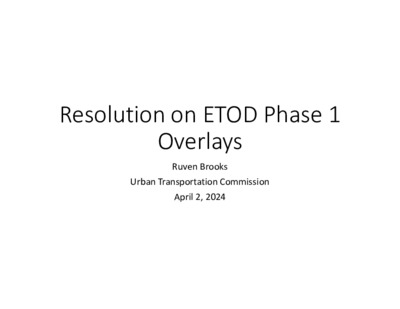04.01 ETOD Recommendation Discussion Guide — original pdf
Backup

Resolution on ETOD Phase 1 Overlays Ruven Brooks Urban Transportation Commission April 2, 2024 We need more housing near transit • ASMP calls for four times as many people using transit as do today • To use transit, people have to live or work within 10 minutes walk/ride of a transit stop • Council resolutions 20230309-016 and 20240201-054 request that City of Austin staff propose bonus programs and other mechanisms for increasing the amount of housing within a half mile of Phase 1 Austin Light Rail and Priority Extensions stops (10 minute walk) Proposed ordinance creates two overlays • “ETOD Overlay combining district (ETOD) will prohibit or make conditional those land uses that are not transit-supportive” • “ETOD Density Bonus combining district (DBETOD) will create a density bonus program that: • Allows residential uses, • Modifies development regulations to increase maximum height (up to 120 feet total), and • Modifies various site development standards.” • Both overlays will be applied within a half-mile of Austin Light Rail stops, including Priority Extensions DBETOD District • Intended to be similar to the DB90 (VMU2 replacement) Combining • Property owners must request a rezoning to add DB90 • Requires a Planning Commission recommendation • Requires a Council action Constraints on transit supportive overlays • Areas around train stops have a wide variety of current zoning • Council specifically limited the new overlay to non single family zoned property (20240201-054) Upcoming City-led ETOD Implementation efforts • Comprehensive Plan (Imagine Austin) amendment to incorporate ETOD • ETOD Overlay • ETOD Overlay (Phase 1 Light Rail Transit + Priority Extensions) • ETOD Overlay (Comprehensive) • Other Transit-Supportive Code Amendments • South Central Waterfront Regulations • Downtown Parking Requirements • Density Bonus Zoning District (Vertical Mixed Use 2 Density Bonus Program Replacement) • Citywide Compatibility modifications • HOME Initiative (One-Unit Minimum Lot Size) • Updates to East Riverside Corridor Plan & Regulating Plan • NLTC and SCTC station area vision plans adoption by City Council • Phase 1 Overlay • Only very few areas available for the overlay • Might be because areas are covered by other code amendments • East Riverside Corridor and Regulating Plan • Might be because of limitation to non single family zoning Alternative: Drop the constraint limiting the bonus plan to non single family zones • Give staff flexibility to suggest modifications to the DBETOD overlay to accommodate single family homes • Example: DBETOD overlay requires 8-9 units to be applicable. Staff could propose an equivalent which permits combining multiple buildings for bonus calculations. • May be necessary to modify the applicable areas to avoid areas in which displacement risk is Active or Vulnerable Why we might need to encourage more housing and jobs in areas of single family homes near transit? • If we want four times as many people walking to transit, areas that are “off limit” for bonus programs means that other areas will have to be made denser • Areas within walking distance of transit will be in high demand • HOME ordinances will probably not increase supply sufficiently